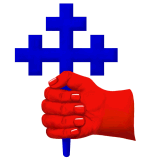Irish Origins
Ulidia and Dalriada in the Sixth Century

| Home |
| Site Summary |
| Background |
| Early Church |
| Saint Finnian |
| Saint Brendan |
| Moluag Pre 562 |
| Saint Comgal |
| Rome |
| Reformation |
| Clan Maclea |
| SiteMap |
"The Church in The British Isles will only begin to grow when She begins to again venerate Her own Saints" (Saint Arsenios of Paros †1877)
It is essential to understand the circumstances of the time to begin to understand the complex situation behind St Moluag and his mission.
The Ulaid were once the most powerful tribal group in the north of Ireland and it is from them the province of Ulster derives its name. In the sixth century the main Ulaid tribes were the Dál nAraide, the Ui Echach Coba (a sub branch of the Dál nAraide), and the Dál Fiatach. Lesser tribal kingdoms included the Dál Riata or Dál Riada.
The Dál Fiatach, the ‘true Ulaid’, settled in Lecale and in the vicinity of Strangford Lough. Their capital at Dun da Lethglas (Downpatrick) was to become an important ecclesiastical centre and the reputed burial place of St. Patrick. In 555 Bangor Abbey was founded by the Cruithne Abbot, Comgal of the Dál nAraide.
From the sixth to tenth centuries the Dál Fiatach, Dal nAraide and Ui Echach Coba shared the kingship of Ulaid. Later, however, the kingship was held by the Dál Fiatach alone. From 1137 the Ulaid rigdamnai (persons eligible to be king) alone used the name Mac Duinnshleibhe. The Mac Duinnshleibhe remained as ‘king of the Irish of Ulidia’ until the 12th century when defeat by the Normans drove them to Lismore in Argyll to join up with their kin the Coarbs of St Moluag.
From about 450 the tribes of the Ulaid were being displaced east by the invading Ui Neill Gaels (O’Neill). The Dál Riada, under pressure from the Ui Neill, began to migrate across the Irish Sea to what is now known as Argyll. In 563, at the Battle of Moneymore (Moin Dairi Lothair), the Ulaid suffered a massive defeat at the hands of the northern Ui Neill. At about this time Fergus Mor son of Erc, King of Dál Riada moved his capital from Ulidia and, with his two brothers Loarn and Angus, established the ancient kingdom of Scots Dalriada.
The three kindred groups each had their own rí (king) and territory. The Cenél Óengusa occupied Islay. The Cenél nGabráin, held Kintyre, Cowal, Bute and Arran. The Cenél Loairn held Colonsay and Lorn and looked on the northern march with the Picts.
In 560 King Brude of the Northern Picts decided that the Dál Riada expansion, which by then had reached as far as Fort William, was threatening his territory so attacked in full force. Brude gave King Gabhran of the Dalriads a drubbing pushing back the borders of the Dalriads to Kintyre . It was into this territorial vacuum that St Moluag arrived.
There was often conflict between the Cenél nGabráin and the Cenél Loairn as each struggled for ascendancy. The Cenél nGabráin enjoyed the overlordship of Dalriada for the sixth and much of the seventh century. However the Cenél Loairn eventually gained ascendancy, becoming kings of Dalriada, and even high kings of the united kingdoms of the Picts and the Scots.
Much of the information available to us comes from the Irish Chronicles. These include, the Annals of Ulster (AU), Tigernach (AT), and the Four Masters (M) together with Chronicum Scotorum (CS). Tighernach was Abbot of Clonmacnoise. In 1150 Christian Malone, Abbot of Clonmacnoise, wrote the Chronicum Scotorum which is largely concerned with the Clonmacnoise and is closely related to the Annals of Tigernach. The Annals of the Four Masters is a compilation of other annals that were available in the seventeenth century. Of most use to us therefore are the Annals of Ulster (AU).
Dr. Kathleen Hughes is clear that the Annals of Ulster (AU) and Tigernach (AT) go back ultimately to the same version that she calls the ‘Chronicle of Ireland’ and that it incorporated a ‘Chronicle of Iona’ and that “entries about Iona, Scottish Dál Riada, and Pictland must have come from it.” From about 740: instead of people ‘going’ to Ireland we have people ‘coming’ to Ireland, indicating the chroniclers moved from Iona to Ireland around that time. The annals very much reflect the partisanship of the time and the spin is no less than we see in politics today.
Last updated 11 July, 2015